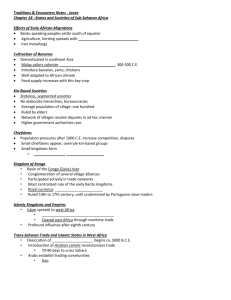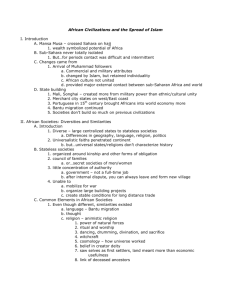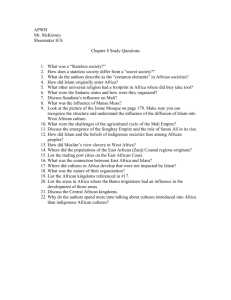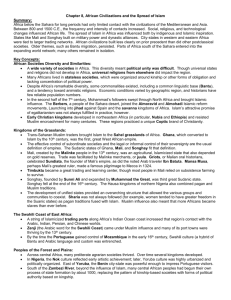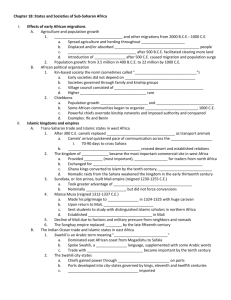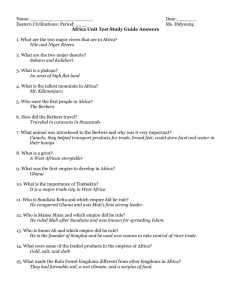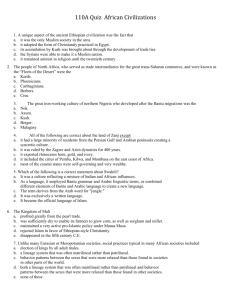Africa
advertisement
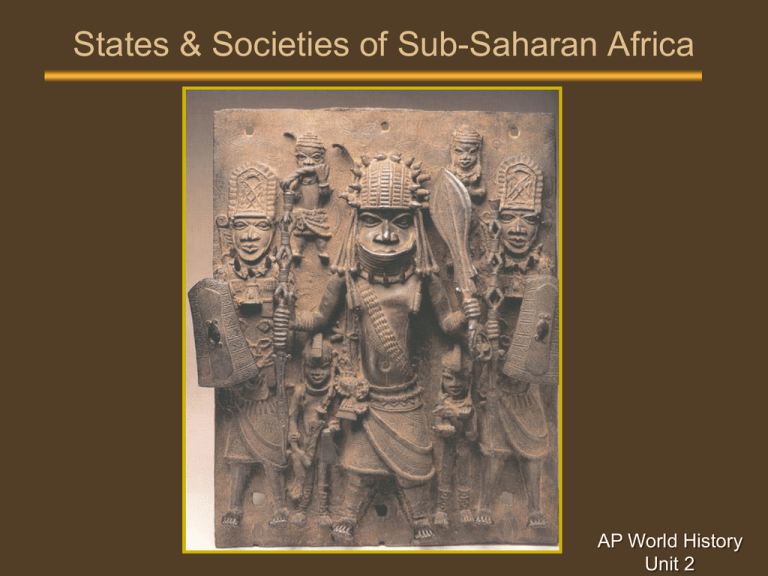
States & Societies of Sub-Saharan Africa AP World History Unit 2 Effects of Early African Migrations • Bantu-speaking peoples settle south of Equator. • Agriculture, herding spreads with Bantu migrations. • Iron. States & Societies of Sub-Saharan Africa • Effects of Early African Migrations – Agriculture & Population Growth • Bananas – Domesticated in south-east Asia – Malay sailors colonize Madagascar, 300-500 CE » Introduce bananas, yams, chickens – Well-adapted to African climate – Food supply increases with this key crop – Population Growth African Religion • Great diversity of religious belief. • Common element: – Single, male creator god. – Lesser deities associated with natural phenomena. • Ancestor worship. • Diviners. – Religious specialists, principally men. – Oracle reading, spells, other rituals. • Limited emphasis on theology. • Morality, balance of nature important. Early Christianity in North Africa • Popular in Egypt and north Africa during the 1st century. Coptic Christianity – Initially weak in sub-Saharan Africa. • The Christian Kingdom of Axum. – 4th century CE. – Located in modern day Ethiopia. – Merchants, then kings convert. – Bible translated into Ethiopian. – Isolated during Islamic period, renaissance during 12th century CE. – Massive churches carved out of solid rock. African Political Organization • Kin-Based Societies – Stateless, segmented societies. – No elaborate hierarchies and bureaucracies. – Average population of village was 100. – Ruled by elders. – Network of villages resolve disputes in an ad hoc manner. – Higher government authorities rare. Yoruba Ruler ~ Nigeria 12th Century CE African Political Organization • Chiefdoms – Population pressures after 1000 increase competition, disputes. – Small chiefdoms appear, overrule kin-based groups. – Small kingdoms form. • Ife, Benin Yoruba Ruler ~ Nigeria 12th Century CE Kingdoms and empires of subSaharan Africa, 800-1500 C.E. Kingdom of the Congo • • • • Basin of the Congo (Zaire) river. Conglomeration of several village alliances. Participated actively in trade. Organization – Most centralized rule of the early Bantu kingdoms. – Royal currency. – Ruled from the 14th-17th century – Undermined by Portuguese slave traders Islamic Kingdoms & Empires • Islam spreads to West Africa. – Trans-Saharan caravans. – Coastal east Africa through maritime trade. • Increased influence after the 8th century. Trans-Saharan Trade & Islamic States in West Africa • Desiccation of Sahara begins around 5000 BCE. • People on both sides had little influence on each other. • Introduction of Arabian camels revolutionizes trade. – One humped dromedary, not native. – 70-90 days to cross Sahara. – Riding saddle developed south of Sahara. • Arabs establish trading communities. – Gao. States & Societies of Sub-Saharan Africa • Islamic Kingdoms & Empires – Trans-Saharan Trade & Islamic States in West Africa • Camels Caravan Approaching Timbuktu, ca. 1850 C.E. 1st Black African “Sudanic” states • • • • • • Emerged in Sahel = Grasslands south of Sahara The Kingdom of Ghana Not related to modern State of Ghana. Developed 4th-5th century CE. Protection against camel-driving raiders. Center of African gold trade. – Imported from south to Ghana. – Also sold ivory, slaves. Islam in West Africa • Kings of Ghana convert in the 10th century CE. – Positive impact on trade and relations with north Africa. – Synthesized Islam with local traditions. • Mali Kingdom emergews w/Sundiata – Mali Ruler – Ruled from 1230-1255 CE. – Empire of Mali extends over Kingdom of Ghana. • Neighboring kingdoms as well. – Took greater advantage of trans-Saharan trade. – Nominally Muslim, but did not force conversions – Mansa Musa = Epic Hajj to Mecca The Indian Ocean Trade & Islamic States in East Africa • East coast maritime trade weak until the 2nd century CE. • Bantu peoples populated the coast. • Swahili (“coasters”) engage in trade with Arabs. – Language a form of Bantu, influenced by Arabic. • 10th century trade increases. The Swahili City-States • Great wealth from the 11th-12th centuries CE. • Development of city-states. • Architecture moved from wood and mud to coral and stone. • Chinese silk and porcelain imported. Zimbabwe • Means “dwelling of the chief”. • Stone complex called “Great Zimbabwe” built early 13th century CE as the capital. • Population reached 18,000 in late 15th century. • Managed trade between internal and coastal regions. Islam in East Africa • Ruling elites in east Africa accepted Islam without forcing general population to convert. • Often retained pagan religious traditions and practices. • Islam serves as social glue with other merchants and states. Arabian Society & Cultural Development • Some kingdoms, empires, and city-states with well-defined classes. – Ruling elites. – Merchant class. – Peasant class. • Other areas in sub-Saharan Africa continue to use traditional kin-based groups. – – – – Extended families, clans. Idea of private property less prevalent. Land held communally. Harvests distributed by elders. Sex & Gender Relations • Men work with specialized skills. – Tanning and iron work. – Heavy labor. • Both sexes work in agriculture. • Male rule more common, but some expanded roles for women. – Merchants, some military activity. • Islamic norms slow to penetrate African society. • Age Grades. – From early agricultural period, Sudan. – Peer groups of single age cohort. – Crosses lines of family & kinship. Slavery & Slave Trading • Practiced since ancient times. • Most slaves captives of war. – Debtors. – Suspected witches. – Criminals. • Used principally in agricultural labor, possession a status symbol. • Trading. – Increased trans-Saharan & Indian Ocean trade stimulates slave trade, 9th century CE. – Africa replaces eastern Europe as principal source of slaves. – Creates internal African slave trade. • More powerful states attack smaller kinship-based groups. • 10,000-20,000 slaves per year. Africa Pop-quiz 1. 2. 3. 4. 5. Who did most of the agricultural work? Did Africans accept all the principles of Islam? Describe “age groups”. How did most slaves become slaves? What two things stimulated the slave trade in the 9th century? 6. Did Africa have an internal slave trade before the arrival of Europeans? 7. What is a diviner? 8. What did Africans place limited emphasis on in religion? 9. What was the first Christian Kingdom in Africa? 10. What modern day African country still maintains Christian since it was established in the 4th century? Label/Outline: Ghana, Mali, Songhay - Outline Kingdom of Kongo Zimbabwe Axum Ethiopian Highlands Niger R. Congo R. Nile R. Zambeze R. Limpopo R. Sahara Desert States and Societies of Sub-Saharan Africa and The Rise of Islam in Africa How was traditional African religion similar to that of early river civilizations? What cultural institution/practice is most responsible for the spread of Islam in western and eastern Africa? Socially, address the extent of Islamic conversion early on in West and Coastal East Africa. Annotate w/arrows spread of Islam to West and Coastal East Africa. Why did the Bantu migrations move primarily in a southern/eastern direction? Socially and religiously, how did coastal East Africa differ from the interior of Africa? What advantage might the Bantus have over other groups they encountered? What is a clear result of cultural contact in East Africa? Economically, how was Zimbabwe similar to the early Axumite kingdom? As for State-less societies, what advantage did chieftains have over kin-based societies? What is the religious commonality between Axum and Egypt? Impact today? How did the West African/Sudanic Kingdoms of Ghana and Mali benefit from location? What difficulties might State-less societies have against organized states? Annotate the map w/arrows & notes illustrating examples of external influence/contact with Africa. Why do you think (couple reasons) the Congo Kingdom will be one the first interior areas impacted by Europeans? How was the early African slave trade different from the later Atlantic slave trade?
